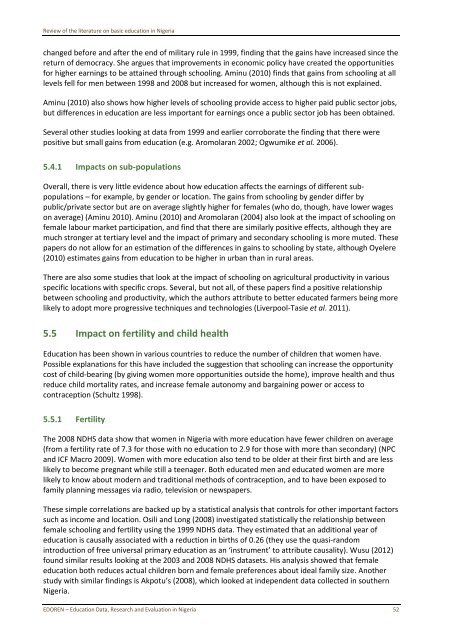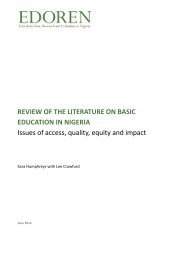Review <str<strong>on</strong>g>of</str<strong>on</strong>g> <str<strong>on</strong>g>the</str<strong>on</strong>g> <str<strong>on</strong>g>literature</str<strong>on</strong>g> <strong>on</strong> <strong>basic</strong> educati<strong>on</strong> <strong>in</strong> Nigeriaadm<strong>in</strong>istered to a sample <str<strong>on</strong>g>of</str<strong>on</strong>g> Primary 3 pupils <strong>in</strong> Bauchi and Sokoto states. This assessment found that<str<strong>on</strong>g>the</str<strong>on</strong>g> vast majority <str<strong>on</strong>g>of</str<strong>on</strong>g> Primary 2 and 3 pupils have not mastered any foundati<strong>on</strong>al read<strong>in</strong>g skills <strong>in</strong> ei<str<strong>on</strong>g>the</str<strong>on</strong>g>rEnglish or Hausa <strong>in</strong> ei<str<strong>on</strong>g>the</str<strong>on</strong>g>r government or IQTE schools. The foundati<strong>on</strong>al skills measured <strong>in</strong> <str<strong>on</strong>g>the</str<strong>on</strong>g>assessment were letter-sound identificati<strong>on</strong>, n<strong>on</strong>-word read<strong>in</strong>g, oral read<strong>in</strong>g fluency, read<strong>in</strong>gcomprehensi<strong>on</strong>, and listen<strong>in</strong>g comprehensi<strong>on</strong>. More specific f<strong>in</strong>d<strong>in</strong>gs were:Over 50% scored zero <strong>on</strong> subtasks; 80 to 90% scored zero for some grades and skills;Pupils <strong>in</strong> Bauchi performed better than those <strong>in</strong> Sokoto;Pupils <strong>in</strong> IQTE schools performed better <strong>on</strong> average than pupils <strong>in</strong> government schools, especially <strong>in</strong>Hausa;There was no significant difference <strong>in</strong> performance between girls and boys <strong>in</strong> both grades <strong>in</strong> <str<strong>on</strong>g>the</str<strong>on</strong>g>government schools, although <str<strong>on</strong>g>the</str<strong>on</strong>g>re was a significant gender difference <strong>in</strong> Bauchi IQTE schools,especially at Stage 2; andPupils’ scores <strong>in</strong>creased slightly from grade to grade but <str<strong>on</strong>g>the</str<strong>on</strong>g> additi<strong>on</strong>al year <str<strong>on</strong>g>of</str<strong>on</strong>g> school<strong>in</strong>g did notproduce mean<strong>in</strong>gful ga<strong>in</strong>s (USAID 2013a).Pupils performed best <strong>on</strong> <str<strong>on</strong>g>the</str<strong>on</strong>g> task <str<strong>on</strong>g>of</str<strong>on</strong>g> hav<strong>in</strong>g a text read to <str<strong>on</strong>g>the</str<strong>on</strong>g>m <strong>in</strong> Hausa (ibid.), perhaps suggest<strong>in</strong>g <str<strong>on</strong>g>the</str<strong>on</strong>g>need to <strong>in</strong>clude more oracy <strong>in</strong> literacy activities (see also Secti<strong>on</strong> 4.3).The 2013 USAID EGMA results were similarly poor, while aga<strong>in</strong> <str<strong>on</strong>g>the</str<strong>on</strong>g> pupils <strong>in</strong> IQTE schools fared slightlybetter. Most pupils scored zero <strong>in</strong> <str<strong>on</strong>g>the</str<strong>on</strong>g> subtasks, which asked pupils to identify numbers, do simpleadditi<strong>on</strong> and subtracti<strong>on</strong>s, discrim<strong>in</strong>ate between quantities, complete miss<strong>in</strong>g numbers <strong>in</strong> a sequence,and solve ma<str<strong>on</strong>g>the</str<strong>on</strong>g>matical problems orally (word problems). The pupils performed much better <strong>on</strong> <str<strong>on</strong>g>the</str<strong>on</strong>g>c<strong>on</strong>textualised orally given word problems, suggest<strong>in</strong>g children have <str<strong>on</strong>g>the</str<strong>on</strong>g> capacity to do better if teachersmake <str<strong>on</strong>g>the</str<strong>on</strong>g> l<strong>in</strong>kages between real-life c<strong>on</strong>texts and more abstract c<strong>on</strong>cepts (USAID 2013 a and b).Overall, <str<strong>on</strong>g>the</str<strong>on</strong>g> evidence from <str<strong>on</strong>g>the</str<strong>on</strong>g> <str<strong>on</strong>g>literature</str<strong>on</strong>g> is c<strong>on</strong>sistent <strong>in</strong> c<strong>on</strong>clud<strong>in</strong>g that learn<strong>in</strong>g outcomes are weak <strong>in</strong>both literacy and numeracy but that <str<strong>on</strong>g>the</str<strong>on</strong>g>y are weaker <strong>in</strong> literacy, even when literacy is assessed <strong>in</strong> alanguage o<str<strong>on</strong>g>the</str<strong>on</strong>g>r than English. In c<strong>on</strong>trast, pupils’ oral skills <strong>in</strong> <str<strong>on</strong>g>the</str<strong>on</strong>g>ir mo<str<strong>on</strong>g>the</str<strong>on</strong>g>r t<strong>on</strong>gue and/or <str<strong>on</strong>g>the</str<strong>on</strong>g> language <str<strong>on</strong>g>of</str<strong>on</strong>g><str<strong>on</strong>g>the</str<strong>on</strong>g> immediate envir<strong>on</strong>ment fared better, and this po<strong>in</strong>ts perhaps to <str<strong>on</strong>g>the</str<strong>on</strong>g> need to <strong>in</strong>corporate more oralwork <strong>in</strong>to both literacy and numeracy teach<strong>in</strong>g.5.4 Impact <strong>on</strong> labour market outcomesIn general, <str<strong>on</strong>g>the</str<strong>on</strong>g> ec<strong>on</strong>omic benefit to <strong>in</strong>dividuals from educati<strong>on</strong> <strong>in</strong> most <str<strong>on</strong>g>of</str<strong>on</strong>g> SSA is low for primary andsec<strong>on</strong>dary school but rises for tertiary educati<strong>on</strong> (Schultz 2004; Teal 2010). This is true <strong>in</strong> Nigeria. Thereis a relatively limited body <str<strong>on</strong>g>of</str<strong>on</strong>g> <str<strong>on</strong>g>literature</str<strong>on</strong>g> <strong>on</strong> <str<strong>on</strong>g>the</str<strong>on</strong>g> impact <str<strong>on</strong>g>of</str<strong>on</strong>g> educati<strong>on</strong> <strong>on</strong> earn<strong>in</strong>gs <strong>in</strong> Nigeria, based <strong>on</strong> astandard ec<strong>on</strong>omic and statistical methodology used <strong>in</strong> countries around <str<strong>on</strong>g>the</str<strong>on</strong>g> world. These papers makeuse <str<strong>on</strong>g>of</str<strong>on</strong>g> nati<strong>on</strong>al household survey data that c<strong>on</strong>vey detailed <strong>in</strong>formati<strong>on</strong> about thousands <str<strong>on</strong>g>of</str<strong>on</strong>g> <strong>in</strong>dividuals,which allow <str<strong>on</strong>g>the</str<strong>on</strong>g>se correlati<strong>on</strong>s to be identified. All <str<strong>on</strong>g>of</str<strong>on</strong>g> <str<strong>on</strong>g>the</str<strong>on</strong>g>se papers are based <strong>on</strong> several years <str<strong>on</strong>g>of</str<strong>on</strong>g> <str<strong>on</strong>g>the</str<strong>on</strong>g>NDHS from between 1996 and 2008. This is <strong>on</strong>e <str<strong>on</strong>g>of</str<strong>on</strong>g> <str<strong>on</strong>g>the</str<strong>on</strong>g> major sample surveys carried out <strong>in</strong> Nigeria, andresembles <str<strong>on</strong>g>the</str<strong>on</strong>g> World Bank’s Liv<strong>in</strong>g Standards Measurement Survey <strong>in</strong> terms <str<strong>on</strong>g>of</str<strong>on</strong>g> variable coverage. Itc<strong>on</strong>ta<strong>in</strong>s detailed demographic <strong>in</strong>formati<strong>on</strong> <strong>on</strong> <strong>in</strong>dividuals, <strong>in</strong>clud<strong>in</strong>g <strong>on</strong> <str<strong>on</strong>g>the</str<strong>on</strong>g>ir earn<strong>in</strong>gs, occupati<strong>on</strong>,school<strong>in</strong>g and household characteristics.Oyelere (2011) estimates <str<strong>on</strong>g>the</str<strong>on</strong>g> <strong>in</strong>come ga<strong>in</strong>s to <strong>in</strong>dividuals from school<strong>in</strong>g based <strong>on</strong> data from 2005. Herf<strong>in</strong>d<strong>in</strong>gs are that <str<strong>on</strong>g>the</str<strong>on</strong>g> ga<strong>in</strong>s are lowest for primary and sec<strong>on</strong>dary educati<strong>on</strong> (4% higher earn<strong>in</strong>gs per year<str<strong>on</strong>g>of</str<strong>on</strong>g> school<strong>in</strong>g) and much higher for tertiary (16% higher earn<strong>in</strong>gs per year <str<strong>on</strong>g>of</str<strong>on</strong>g> school<strong>in</strong>g). This estimate isbased <strong>on</strong> self-reported <strong>in</strong>come so may be <strong>in</strong>accurate, but does set out to cover both formal employmentand <strong>in</strong>formal self-employment activities. The numbers <str<strong>on</strong>g>of</str<strong>on</strong>g> people who enjoy <str<strong>on</strong>g>the</str<strong>on</strong>g> higher ga<strong>in</strong>s fromtertiary educati<strong>on</strong> are relatively small – <strong>on</strong>ly 7.8% <str<strong>on</strong>g>of</str<strong>on</strong>g> <str<strong>on</strong>g>the</str<strong>on</strong>g> populati<strong>on</strong> aged 15 and over have some postsec<strong>on</strong>daryeducati<strong>on</strong> (NPC and RTI Internati<strong>on</strong>al 2011). Oyelere also compares how <str<strong>on</strong>g>the</str<strong>on</strong>g> ga<strong>in</strong>s haveEDOREN – Educati<strong>on</strong> Data, Research and Evaluati<strong>on</strong> <strong>in</strong> Nigeria 51
Review <str<strong>on</strong>g>of</str<strong>on</strong>g> <str<strong>on</strong>g>the</str<strong>on</strong>g> <str<strong>on</strong>g>literature</str<strong>on</strong>g> <strong>on</strong> <strong>basic</strong> educati<strong>on</strong> <strong>in</strong> Nigeriachanged before and after <str<strong>on</strong>g>the</str<strong>on</strong>g> end <str<strong>on</strong>g>of</str<strong>on</strong>g> military rule <strong>in</strong> 1999, f<strong>in</strong>d<strong>in</strong>g that <str<strong>on</strong>g>the</str<strong>on</strong>g> ga<strong>in</strong>s have <strong>in</strong>creased s<strong>in</strong>ce <str<strong>on</strong>g>the</str<strong>on</strong>g>return <str<strong>on</strong>g>of</str<strong>on</strong>g> democracy. She argues that improvements <strong>in</strong> ec<strong>on</strong>omic policy have created <str<strong>on</strong>g>the</str<strong>on</strong>g> opportunitiesfor higher earn<strong>in</strong>gs to be atta<strong>in</strong>ed through school<strong>in</strong>g. Am<strong>in</strong>u (2010) f<strong>in</strong>ds that ga<strong>in</strong>s from school<strong>in</strong>g at alllevels fell for men between 1998 and 2008 but <strong>in</strong>creased for women, although this is not expla<strong>in</strong>ed.Am<strong>in</strong>u (2010) also shows how higher levels <str<strong>on</strong>g>of</str<strong>on</strong>g> school<strong>in</strong>g provide access to higher paid public sector jobs,but differences <strong>in</strong> educati<strong>on</strong> are less important for earn<strong>in</strong>gs <strong>on</strong>ce a public sector job has been obta<strong>in</strong>ed.Several o<str<strong>on</strong>g>the</str<strong>on</strong>g>r studies look<strong>in</strong>g at data from 1999 and earlier corroborate <str<strong>on</strong>g>the</str<strong>on</strong>g> f<strong>in</strong>d<strong>in</strong>g that <str<strong>on</strong>g>the</str<strong>on</strong>g>re werepositive but small ga<strong>in</strong>s from educati<strong>on</strong> (e.g. Aromolaran 2002; Ogwumike et al. 2006).5.4.1 Impacts <strong>on</strong> sub-populati<strong>on</strong>sOverall, <str<strong>on</strong>g>the</str<strong>on</strong>g>re is very little evidence about how educati<strong>on</strong> affects <str<strong>on</strong>g>the</str<strong>on</strong>g> earn<strong>in</strong>gs <str<strong>on</strong>g>of</str<strong>on</strong>g> different subpopulati<strong>on</strong>s– for example, by gender or locati<strong>on</strong>. The ga<strong>in</strong>s from school<strong>in</strong>g by gender differ bypublic/private sector but are <strong>on</strong> average slightly higher for females (who do, though, have lower wages<strong>on</strong> average) (Am<strong>in</strong>u 2010). Am<strong>in</strong>u (2010) and Aromolaran (2004) also look at <str<strong>on</strong>g>the</str<strong>on</strong>g> impact <str<strong>on</strong>g>of</str<strong>on</strong>g> school<strong>in</strong>g <strong>on</strong>female labour market participati<strong>on</strong>, and f<strong>in</strong>d that <str<strong>on</strong>g>the</str<strong>on</strong>g>re are similarly positive effects, although <str<strong>on</strong>g>the</str<strong>on</strong>g>y aremuch str<strong>on</strong>ger at tertiary level and <str<strong>on</strong>g>the</str<strong>on</strong>g> impact <str<strong>on</strong>g>of</str<strong>on</strong>g> primary and sec<strong>on</strong>dary school<strong>in</strong>g is more muted. Thesepapers do not allow for an estimati<strong>on</strong> <str<strong>on</strong>g>of</str<strong>on</strong>g> <str<strong>on</strong>g>the</str<strong>on</strong>g> differences <strong>in</strong> ga<strong>in</strong>s to school<strong>in</strong>g by state, although Oyelere(2010) estimates ga<strong>in</strong>s from educati<strong>on</strong> to be higher <strong>in</strong> urban than <strong>in</strong> rural areas.There are also some studies that look at <str<strong>on</strong>g>the</str<strong>on</strong>g> impact <str<strong>on</strong>g>of</str<strong>on</strong>g> school<strong>in</strong>g <strong>on</strong> agricultural productivity <strong>in</strong> variousspecific locati<strong>on</strong>s with specific crops. Several, but not all, <str<strong>on</strong>g>of</str<strong>on</strong>g> <str<strong>on</strong>g>the</str<strong>on</strong>g>se papers f<strong>in</strong>d a positive relati<strong>on</strong>shipbetween school<strong>in</strong>g and productivity, which <str<strong>on</strong>g>the</str<strong>on</strong>g> authors attribute to better educated farmers be<strong>in</strong>g morelikely to adopt more progressive techniques and technologies (Liverpool-Tasie et al. 2011).5.5 Impact <strong>on</strong> fertility and child healthEducati<strong>on</strong> has been shown <strong>in</strong> various countries to reduce <str<strong>on</strong>g>the</str<strong>on</strong>g> number <str<strong>on</strong>g>of</str<strong>on</strong>g> children that women have.Possible explanati<strong>on</strong>s for this have <strong>in</strong>cluded <str<strong>on</strong>g>the</str<strong>on</strong>g> suggesti<strong>on</strong> that school<strong>in</strong>g can <strong>in</strong>crease <str<strong>on</strong>g>the</str<strong>on</strong>g> opportunitycost <str<strong>on</strong>g>of</str<strong>on</strong>g> child-bear<strong>in</strong>g (by giv<strong>in</strong>g women more opportunities outside <str<strong>on</strong>g>the</str<strong>on</strong>g> home), improve health and thusreduce child mortality rates, and <strong>in</strong>crease female aut<strong>on</strong>omy and barga<strong>in</strong><strong>in</strong>g power or access toc<strong>on</strong>tracepti<strong>on</strong> (Schultz 1998).5.5.1 FertilityThe 2008 NDHS data show that women <strong>in</strong> Nigeria with more educati<strong>on</strong> have fewer children <strong>on</strong> average(from a fertility rate <str<strong>on</strong>g>of</str<strong>on</strong>g> 7.3 for those with no educati<strong>on</strong> to 2.9 for those with more than sec<strong>on</strong>dary) (NPCand ICF Macro 2009). Women with more educati<strong>on</strong> also tend to be older at <str<strong>on</strong>g>the</str<strong>on</strong>g>ir first birth and are lesslikely to become pregnant while still a teenager. Both educated men and educated women are morelikely to know about modern and traditi<strong>on</strong>al methods <str<strong>on</strong>g>of</str<strong>on</strong>g> c<strong>on</strong>tracepti<strong>on</strong>, and to have been exposed t<str<strong>on</strong>g>of</str<strong>on</strong>g>amily plann<strong>in</strong>g messages via radio, televisi<strong>on</strong> or newspapers.These simple correlati<strong>on</strong>s are backed up by a statistical analysis that c<strong>on</strong>trols for o<str<strong>on</strong>g>the</str<strong>on</strong>g>r important factorssuch as <strong>in</strong>come and locati<strong>on</strong>. Osili and L<strong>on</strong>g (2008) <strong>in</strong>vestigated statistically <str<strong>on</strong>g>the</str<strong>on</strong>g> relati<strong>on</strong>ship betweenfemale school<strong>in</strong>g and fertility us<strong>in</strong>g <str<strong>on</strong>g>the</str<strong>on</strong>g> 1999 NDHS data. They estimated that an additi<strong>on</strong>al year <str<strong>on</strong>g>of</str<strong>on</strong>g>educati<strong>on</strong> is causally associated with a reducti<strong>on</strong> <strong>in</strong> births <str<strong>on</strong>g>of</str<strong>on</strong>g> 0.26 (<str<strong>on</strong>g>the</str<strong>on</strong>g>y use <str<strong>on</strong>g>the</str<strong>on</strong>g> quasi-random<strong>in</strong>troducti<strong>on</strong> <str<strong>on</strong>g>of</str<strong>on</strong>g> free universal primary educati<strong>on</strong> as an ‘<strong>in</strong>strument’ to attribute causality). Wusu (2012)found similar results look<strong>in</strong>g at <str<strong>on</strong>g>the</str<strong>on</strong>g> 2003 and 2008 NDHS datasets. His analysis showed that femaleeducati<strong>on</strong> both reduces actual children born and female preferences about ideal family size. Ano<str<strong>on</strong>g>the</str<strong>on</strong>g>rstudy with similar f<strong>in</strong>d<strong>in</strong>gs is Akpotu’s (2008), which looked at <strong>in</strong>dependent data collected <strong>in</strong> sou<str<strong>on</strong>g>the</str<strong>on</strong>g>rnNigeria.EDOREN – Educati<strong>on</strong> Data, Research and Evaluati<strong>on</strong> <strong>in</strong> Nigeria 52
- Page 1 and 2:
REVIEW OF THE LITERATURE ON BASICED
- Page 3 and 4:
Review of
- Page 5 and 6:
Review of
- Page 7 and 8:
Review of
- Page 9 and 10:
Review of
- Page 11 and 12:
Review of
- Page 13 and 14:
Review of
- Page 15 and 16:
Review of
- Page 17 and 18:
Review of
- Page 19 and 20:
Review of
- Page 21 and 22:
Review of
- Page 23 and 24:
Review of
- Page 25 and 26:
Review of
- Page 27 and 28: Review of
- Page 29 and 30: Review of
- Page 31 and 32: Review of
- Page 33 and 34: Review of
- Page 35 and 36: Review of
- Page 37 and 38: Review of
- Page 39 and 40: Review of
- Page 41 and 42: Review of
- Page 43 and 44: Review of
- Page 45 and 46: Review of
- Page 47 and 48: Review of
- Page 49 and 50: Review of
- Page 51 and 52: Review of
- Page 53 and 54: Review of
- Page 55 and 56: Review of
- Page 57 and 58: Review of
- Page 59 and 60: Review of
- Page 61 and 62: Review of
- Page 63 and 64: Review of
- Page 65 and 66: Review of
- Page 67 and 68: Review of
- Page 69 and 70: Review of
- Page 71 and 72: Review of
- Page 73 and 74: Review of
- Page 75 and 76: Review of
- Page 77: Review of
- Page 81 and 82: Review of
- Page 83 and 84: Review of
- Page 85 and 86: Review of
- Page 87 and 88: Review of
- Page 89 and 90: Review of
- Page 91 and 92: Review of
- Page 93 and 94: Review of
- Page 95 and 96: Review of
- Page 97 and 98: Review of
- Page 99 and 100: Review of
- Page 101 and 102: Review of
- Page 103 and 104: Review of
- Page 105 and 106: Review of
- Page 107 and 108: Review of
- Page 109 and 110: Review of
- Page 111 and 112: Review of
- Page 113 and 114: Review of
- Page 115 and 116: Review of
- Page 117 and 118: Review of
- Page 119 and 120: Review of
- Page 121 and 122: Review of
- Page 123 and 124: Review of
- Page 125 and 126: Review of
- Page 127 and 128: Review of
- Page 129 and 130:
Review of
- Page 131 and 132:
Review of
- Page 133 and 134:
Review of
- Page 135 and 136:
Review of
- Page 137 and 138:
Review of
- Page 139 and 140:
Review of
- Page 141 and 142:
Review of
- Page 143 and 144:
Review of
- Page 145 and 146:
Review of
- Page 147 and 148:
Review of
- Page 149 and 150:
Review of
- Page 151 and 152:
Review of
- Page 153 and 154:
Review of
- Page 155 and 156:
Review of
- Page 157 and 158:
Review of
- Page 159 and 160:
Review of
- Page 161 and 162:
Review of
- Page 163 and 164:
Review of
- Page 165 and 166:
Review of
- Page 167 and 168:
Review of
- Page 169 and 170:
Review of
- Page 171 and 172:
Review of
- Page 173 and 174:
Review of
- Page 175 and 176:
Review of
- Page 177 and 178:
Review of
- Page 179 and 180:
Review of
- Page 181 and 182:
Review of
- Page 183 and 184:
Review of
- Page 185 and 186:
Review of
- Page 187 and 188:
Review of
- Page 189 and 190:
Review of
- Page 191 and 192:
Review of
- Page 193 and 194:
Review of
- Page 195 and 196:
Review of
- Page 197 and 198:
Review of
- Page 199 and 200:
Review of
- Page 201 and 202:
Review of
- Page 203 and 204:
Review of
- Page 205 and 206:
Review of
- Page 207 and 208:
Review of
- Page 209 and 210:
Review of



